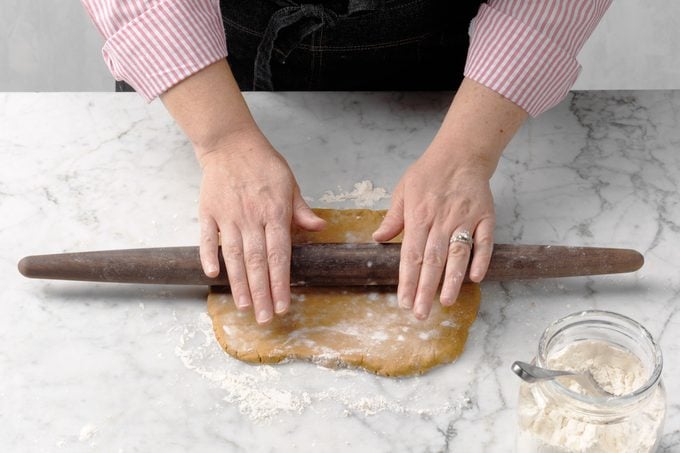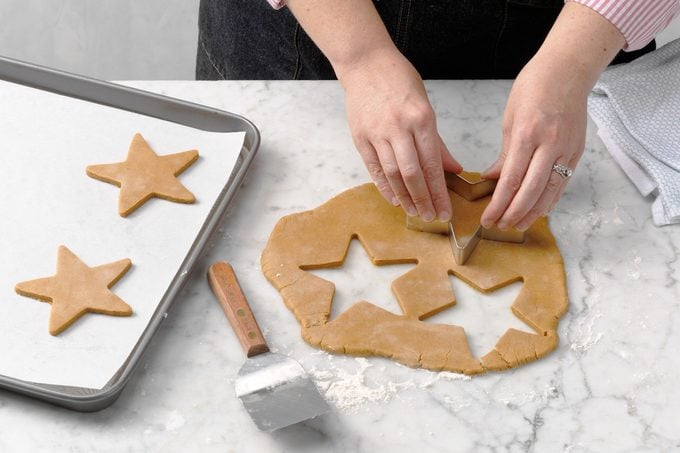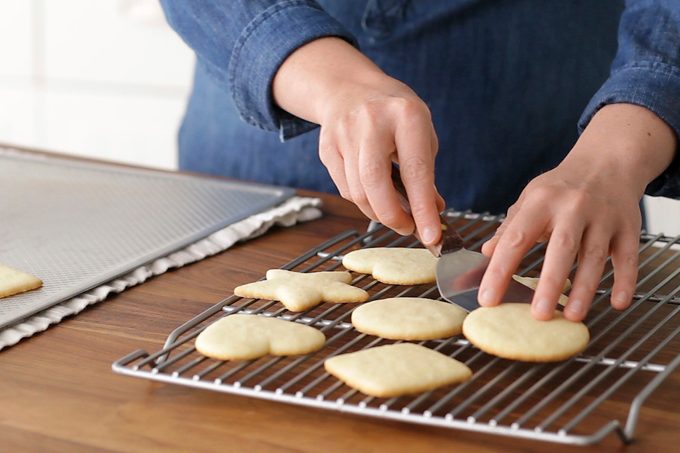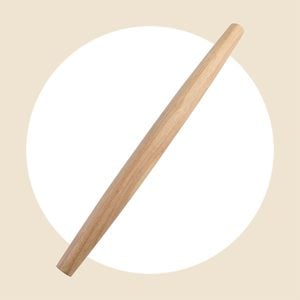How to Use Cookie Cutters to Make Cutout Cookies
Updated: Nov. 10, 2023
This step-by-step guide will show you how to use cookie cutters to make the best cutout cookies for every occasion.
Using cookie cutters is a fun way to make decorative cookies for different holidays and occasions. Whether you’re making everyday cookies or baking for a special celebration, here’s how to use cookie cutters to make the best cutout cookies.
On This Page
The Best Cookie Cutters to Use
Cookie cutters come in many different forms, from plastic to aluminum and stainless steel. There isn’t one particular material that works best, according to our Test Kitchen. But for optimal results, use sturdy cutters that will hold their shape when you apply pressure.
If you’re looking for a very specific or personalized shape, 3D-printed cutters are a great option. You can find customized 3D-printed cookie cutters on Etsy. (Just keep in mind, they’re typically hand-wash only.)
Other Tools for Cutout Cookies
- Rolling pin: The type of rolling pin you use is a personal preference. A good tapered (sometimes called French) rolling pin is a great all-purpose option for cookies, pie crusts and more.
- Baking sheets: Make sure you have a few cookie sheets on hand for this project. Our Test Kitchen tried out many brands, and Caraway’s baking sheet was one of their favorites for making cutout cookies.
- Parchment paper: For easy cleanup and even baking, line your baking sheets with parchment paper.
How to Use Cookie Cutters
These instructions focus specifically on how to use cookie cutters. Step 1: Choose the right cookie recipe

Although you can use cookie cutters with any type of cookie dough, you’ll get the best results by choosing the right type of dough for your project.
For more intricate, decorative cutout cookies, our Test Kitchen recommends using a sturdy dough like the one in our recipe for Santa’s Elf Cookies. Dough that’s too wet or fragile can be frustrating to work with. If you’re using a dough that you know tends to spread and melt in the oven, stick to simple shapes like rounds.
Test Kitchen Tip: If you’re willing to experiment, you can alter recipes to make them more stable and better for cutouts. For example, try substituting some of the granulated sugar for confectioners’ sugar or slightly increasing the flour. But remember—adapting a recipe takes patience!
Step 2: Roll out the dough

After preparing your cookie dough, refrigerate it for at least 1 hour. This will make the dough easier to cut with cookie cutters (especially intricate ones) and may help prevent your cookies from spreading in the oven.
Once the dough is chilled, roll it out on a cool, lightly floured surface. (Here’s how to roll out cookie dough like a pro!) Keep the dough’s thickness as even as possible so that the cookies will cook consistently. Many recipes call for 1/4-inch thick dough, but follow your recipe’s directions.
Test Kitchen Tip: Measure your dough’s thickness with a ruler or use this measured rolling pin, which has indentations to guarantee an even thickness. It comes in 1/4-inch and 1/8-inch sizes.
Step 3: Cut out the cookies

Now it’s time to cut out your cookie shapes. To prevent sticking, dust your cookie cutters with flour before firmly pressing them into the dough.
Use a thin spatula to transfer the cutouts onto a cookie sheet, spacing them at least 1 inch apart. Bake according to the recipe directions. Remove the cookies from the oven and let them cool for a few minutes before transferring them to a wire rack to cool completely.
Step 4: Repeat

If you’re making multiple batches of cookies, keep the extra dough chilled while the initial batches are baking. Once you take each batch out of the oven, let the cookie sheet cool completely before loading it up with the next batch of dough.
Test Kitchen Tip: You can recycle dough scraps by combining them and rolling them out again—just make sure the dough is still chilled. However, avoid re-rolling the dough too many times—it could become tough. (Check out our other tips for making cutout cookies.)
Tips for Using Cookie Cutters
How do I prevent the cookie cutters from sticking to the dough?
An easy way to prevent cookie cutters from sticking to the dough is to quickly dip the edges of the cutter in flour before pressing it into the sheet of dough. Repeat after each cut.
If your cookies still stick, use a small spatula or offset spatula to press the cookie out of the mold.
How do I prevent the rolling pin from sticking to the dough?
To keep the cookie dough from sticking to the dough, first ensure that you let the dough chill in the fridge for at least 30 minutes. Cold dough is less likely to become sticky.
You can also prevent your rolling pin from sticking by dusting it with a bit of flour. You can also layer the cookie dough between sheets of parchment paper and roll it out. When you’re ready to cut, peel away the top layer of parchment and press the cookie cutters into the dough.
How do you make cutout cookies that keep their shape?
Choosing the right recipe is key to making cutout cookies that will keep their shape. A sturdy dough made with confectioners’ sugar instead of granulated sugar is a great option. It’s also important to use chilled dough. If your dough is too warm, the butter will melt too quickly in the oven.
Check out these other tips to keep cookies from spreading.
How do I get the clearest details in my cookie cutouts?
To get crisp edges and clear detail, make sure you’re working with cool dough. You can even place the cutouts in the fridge for 15 minutes to firm up. This will help the cookies retain their definition.
How much dough should I roll out at a time?
Don’t feel like you have to roll out a full batch of dough at a time. For best results, divide your cookie dough into halves or thirds. Wrap each of these portions in waxed paper and stash them in the fridge until you’re ready to use them.
These smaller portions—just a few cups worth of dough—are easy to work with and won’t take up every inch of counter space.
What else can you use cookie cutters for?
There are many other ways to use cookie cutters that don’t involve baking—use them as a stencil for crafts, hang them as Christmas ornaments or use them to make fun-shaped pancakes. You can also repurpose cookie cutter shapes in creative ways—a diamond can be an elf, a crescent moon can be a watermelon and a Christmas bell can be a ghost!
Josh Rink, Taste of Home food stylist, contributed to this article.




